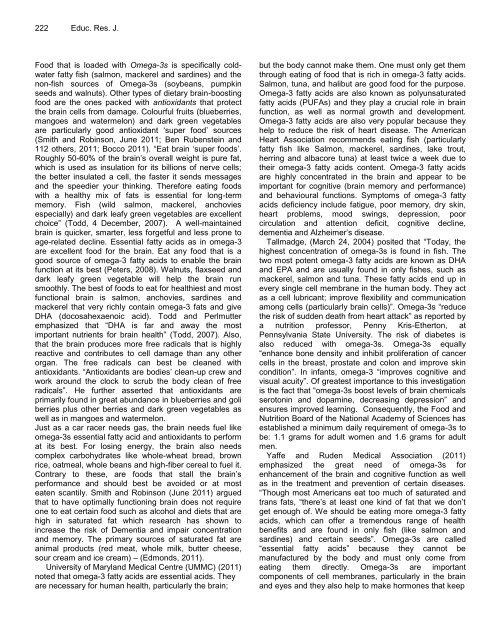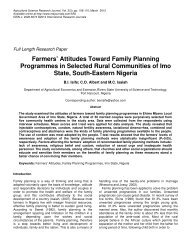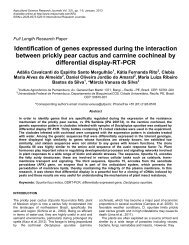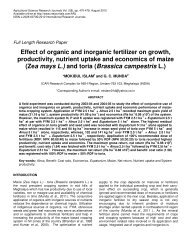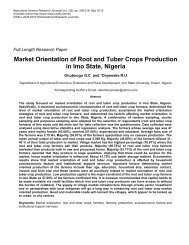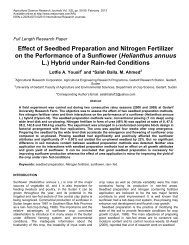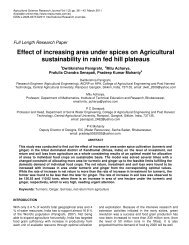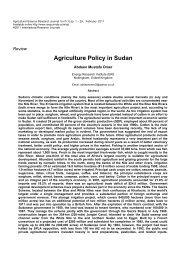Lumosity training and brain-boosting food effects on learning
Lumosity training and brain-boosting food effects on learning
Lumosity training and brain-boosting food effects on learning
- No tags were found...
You also want an ePaper? Increase the reach of your titles
YUMPU automatically turns print PDFs into web optimized ePapers that Google loves.
222 Educ. Res. J.Food that is loaded with Omega-3s is specifically coldwaterfatty fish (salm<strong>on</strong>, mackerel <str<strong>on</strong>g>and</str<strong>on</strong>g> sardines) <str<strong>on</strong>g>and</str<strong>on</strong>g> then<strong>on</strong>-fish sources of Omega-3s (soybeans, pumpkinseeds <str<strong>on</strong>g>and</str<strong>on</strong>g> walnuts). Other types of dietary <str<strong>on</strong>g>brain</str<strong>on</strong>g>-<str<strong>on</strong>g>boosting</str<strong>on</strong>g><str<strong>on</strong>g>food</str<strong>on</strong>g> are the <strong>on</strong>es packed with antioxidants that protectthe <str<strong>on</strong>g>brain</str<strong>on</strong>g> cells from damage. Colourful fruits (blueberries,mangoes <str<strong>on</strong>g>and</str<strong>on</strong>g> watermel<strong>on</strong>) <str<strong>on</strong>g>and</str<strong>on</strong>g> dark green vegetablesare particularly good antioxidant ‘super <str<strong>on</strong>g>food</str<strong>on</strong>g>’ sources(Smith <str<strong>on</strong>g>and</str<strong>on</strong>g> Robins<strong>on</strong>, June 2011; Ben Rubenstein <str<strong>on</strong>g>and</str<strong>on</strong>g>112 others, 2011; Bocco 2011). “Eat <str<strong>on</strong>g>brain</str<strong>on</strong>g> ‘super <str<strong>on</strong>g>food</str<strong>on</strong>g>s’.Roughly 50-60% of the <str<strong>on</strong>g>brain</str<strong>on</strong>g>’s overall weight is pure fat,which is used as insulati<strong>on</strong> for its billi<strong>on</strong>s of nerve cells;the better insulated a cell, the faster it sends messages<str<strong>on</strong>g>and</str<strong>on</strong>g> the speedier your thinking. Therefore eating <str<strong>on</strong>g>food</str<strong>on</strong>g>swith a healthy mix of fats is essential for l<strong>on</strong>g-termmemory. Fish (wild salm<strong>on</strong>, mackerel, anchoviesespecially) <str<strong>on</strong>g>and</str<strong>on</strong>g> dark leafy green vegetables are excellentchoice” (Todd, 4 December, 2007). A well-maintained<str<strong>on</strong>g>brain</str<strong>on</strong>g> is quicker, smarter, less forgetful <str<strong>on</strong>g>and</str<strong>on</strong>g> less pr<strong>on</strong>e toage-related decline. Essential fatty acids as in omega-3are excellent <str<strong>on</strong>g>food</str<strong>on</strong>g> for the <str<strong>on</strong>g>brain</str<strong>on</strong>g>. Eat any <str<strong>on</strong>g>food</str<strong>on</strong>g> that is agood source of omega-3 fatty acids to enable the <str<strong>on</strong>g>brain</str<strong>on</strong>g>functi<strong>on</strong> at its best (Peters, 2008). Walnuts, flaxseed <str<strong>on</strong>g>and</str<strong>on</strong>g>dark leafy green vegetable will help the <str<strong>on</strong>g>brain</str<strong>on</strong>g> runsmoothly. The best of <str<strong>on</strong>g>food</str<strong>on</strong>g>s to eat for healthiest <str<strong>on</strong>g>and</str<strong>on</strong>g> mostfuncti<strong>on</strong>al <str<strong>on</strong>g>brain</str<strong>on</strong>g> is salm<strong>on</strong>, anchovies, sardines <str<strong>on</strong>g>and</str<strong>on</strong>g>mackerel that very richly c<strong>on</strong>tain omega-3 fats <str<strong>on</strong>g>and</str<strong>on</strong>g> giveDHA (docosahexaenoic acid). Todd <str<strong>on</strong>g>and</str<strong>on</strong>g> Perlmutteremphasized that “DHA is far <str<strong>on</strong>g>and</str<strong>on</strong>g> away the mostimportant nutrients for <str<strong>on</strong>g>brain</str<strong>on</strong>g> health” (Todd, 2007). Also,that the <str<strong>on</strong>g>brain</str<strong>on</strong>g> produces more free radicals that is highlyreactive <str<strong>on</strong>g>and</str<strong>on</strong>g> c<strong>on</strong>tributes to cell damage than any otherorgan. The free radicals can best be cleaned withantioxidants. “Antioxidants are bodies’ clean-up crew <str<strong>on</strong>g>and</str<strong>on</strong>g>work around the clock to scrub the body clean of freeradicals”. He further asserted that antioxidants areprimarily found in great abundance in blueberries <str<strong>on</strong>g>and</str<strong>on</strong>g> goliberries plus other berries <str<strong>on</strong>g>and</str<strong>on</strong>g> dark green vegetables aswell as in mangoes <str<strong>on</strong>g>and</str<strong>on</strong>g> watermel<strong>on</strong>.Just as a car racer needs gas, the <str<strong>on</strong>g>brain</str<strong>on</strong>g> needs fuel likeomega-3s essential fatty acid <str<strong>on</strong>g>and</str<strong>on</strong>g> antioxidants to performat its best. For losing energy, the <str<strong>on</strong>g>brain</str<strong>on</strong>g> also needscomplex carbohydrates like whole-wheat bread, brownrice, oatmeal, whole beans <str<strong>on</strong>g>and</str<strong>on</strong>g> high-fiber cereal to fuel it.C<strong>on</strong>trary to these, are <str<strong>on</strong>g>food</str<strong>on</strong>g>s that stall the <str<strong>on</strong>g>brain</str<strong>on</strong>g>’sperformance <str<strong>on</strong>g>and</str<strong>on</strong>g> should best be avoided or at mosteaten scantily. Smith <str<strong>on</strong>g>and</str<strong>on</strong>g> Robins<strong>on</strong> (June 2011) arguedthat to have optimally functi<strong>on</strong>ing <str<strong>on</strong>g>brain</str<strong>on</strong>g> does not require<strong>on</strong>e to eat certain <str<strong>on</strong>g>food</str<strong>on</strong>g> such as alcohol <str<strong>on</strong>g>and</str<strong>on</strong>g> diets that arehigh in saturated fat which research has shown toincrease the risk of Dementia <str<strong>on</strong>g>and</str<strong>on</strong>g> impair c<strong>on</strong>centrati<strong>on</strong><str<strong>on</strong>g>and</str<strong>on</strong>g> memory. The primary sources of saturated fat areanimal products (red meat, whole milk, butter cheese,sour cream <str<strong>on</strong>g>and</str<strong>on</strong>g> ice cream) – (Edm<strong>on</strong>ds, 2011).University of Maryl<str<strong>on</strong>g>and</str<strong>on</strong>g> Medical Centre (UMMC) (2011)noted that omega-3 fatty acids are essential acids. Theyare necessary for human health, particularly the <str<strong>on</strong>g>brain</str<strong>on</strong>g>;but the body cannot make them. One must <strong>on</strong>ly get themthrough eating of <str<strong>on</strong>g>food</str<strong>on</strong>g> that is rich in omega-3 fatty acids.Salm<strong>on</strong>, tuna, <str<strong>on</strong>g>and</str<strong>on</strong>g> halibut are good <str<strong>on</strong>g>food</str<strong>on</strong>g> for the purpose.Omega-3 fatty acids are also known as polyunsaturatedfatty acids (PUFAs) <str<strong>on</strong>g>and</str<strong>on</strong>g> they play a crucial role in <str<strong>on</strong>g>brain</str<strong>on</strong>g>functi<strong>on</strong>, as well as normal growth <str<strong>on</strong>g>and</str<strong>on</strong>g> development.Omega-3 fatty acids are also very popular because theyhelp to reduce the risk of heart disease. The AmericanHeart Associati<strong>on</strong> recommends eating fish (particularlyfatty fish like Salm<strong>on</strong>, mackerel, sardines, lake trout,herring <str<strong>on</strong>g>and</str<strong>on</strong>g> albacore tuna) at least twice a week due totheir omega-3 fatty acids c<strong>on</strong>tent. Omega-3 fatty acidsare highly c<strong>on</strong>centrated in the <str<strong>on</strong>g>brain</str<strong>on</strong>g> <str<strong>on</strong>g>and</str<strong>on</strong>g> appear to beimportant for cognitive (<str<strong>on</strong>g>brain</str<strong>on</strong>g> memory <str<strong>on</strong>g>and</str<strong>on</strong>g> performance)<str<strong>on</strong>g>and</str<strong>on</strong>g> behavioural functi<strong>on</strong>s. Symptoms of omega-3 fattyacids deficiency include fatigue, poor memory, dry skin,heart problems, mood swings, depressi<strong>on</strong>, poorcirculati<strong>on</strong> <str<strong>on</strong>g>and</str<strong>on</strong>g> attenti<strong>on</strong> deficit, cognitive decline,dementia <str<strong>on</strong>g>and</str<strong>on</strong>g> Alzheimer’s disease.Tallmadge, (March 24, 2004) posited that “Today, thehighest c<strong>on</strong>centrati<strong>on</strong> of omega-3s is found in fish. Thetwo most potent omega-3 fatty acids are known as DHA<str<strong>on</strong>g>and</str<strong>on</strong>g> EPA <str<strong>on</strong>g>and</str<strong>on</strong>g> are usually found in <strong>on</strong>ly fishes, such asmackerel, salm<strong>on</strong> <str<strong>on</strong>g>and</str<strong>on</strong>g> tuna. These fatty acids end up inevery single cell membrane in the human body. They actas a cell lubricant; improve flexibility <str<strong>on</strong>g>and</str<strong>on</strong>g> communicati<strong>on</strong>am<strong>on</strong>g cells (particularly <str<strong>on</strong>g>brain</str<strong>on</strong>g> cells)”. Omega-3s “reducethe risk of sudden death from heart attack” as reported bya nutriti<strong>on</strong> professor, Penny Kris-Ethert<strong>on</strong>, atPennsylvania State University. The risk of diabetes isalso reduced with omega-3s. Omega-3s equally“enhance b<strong>on</strong>e density <str<strong>on</strong>g>and</str<strong>on</strong>g> inhibit proliferati<strong>on</strong> of cancercells in the breast, prostate <str<strong>on</strong>g>and</str<strong>on</strong>g> col<strong>on</strong> <str<strong>on</strong>g>and</str<strong>on</strong>g> improve skinc<strong>on</strong>diti<strong>on</strong>”. In infants, omega-3 “improves cognitive <str<strong>on</strong>g>and</str<strong>on</strong>g>visual acuity”. Of greatest importance to this investigati<strong>on</strong>is the fact that “omega-3s boost levels of <str<strong>on</strong>g>brain</str<strong>on</strong>g> chemicalsserot<strong>on</strong>in <str<strong>on</strong>g>and</str<strong>on</strong>g> dopamine, decreasing depressi<strong>on</strong>” <str<strong>on</strong>g>and</str<strong>on</strong>g>ensures improved <strong>learning</strong>. C<strong>on</strong>sequently, the Food <str<strong>on</strong>g>and</str<strong>on</strong>g>Nutriti<strong>on</strong> Board of the Nati<strong>on</strong>al Academy of Sciences hasestablished a minimum daily requirement of omega-3s tobe: 1.1 grams for adult women <str<strong>on</strong>g>and</str<strong>on</strong>g> 1.6 grams for adultmen.Yaffe <str<strong>on</strong>g>and</str<strong>on</strong>g> Ruden Medical Associati<strong>on</strong> (2011)emphasized the great need of omega-3s forenhancement of the <str<strong>on</strong>g>brain</str<strong>on</strong>g> <str<strong>on</strong>g>and</str<strong>on</strong>g> cognitive functi<strong>on</strong> as wellas in the treatment <str<strong>on</strong>g>and</str<strong>on</strong>g> preventi<strong>on</strong> of certain diseases.“Though most Americans eat too much of saturated <str<strong>on</strong>g>and</str<strong>on</strong>g>trans fats, “there’s at least <strong>on</strong>e kind of fat that we d<strong>on</strong>’tget enough of. We should be eating more omega-3 fattyacids, which can offer a tremendous range of healthbenefits <str<strong>on</strong>g>and</str<strong>on</strong>g> are found in <strong>on</strong>ly fish (like salm<strong>on</strong> <str<strong>on</strong>g>and</str<strong>on</strong>g>sardines) <str<strong>on</strong>g>and</str<strong>on</strong>g> certain seeds”. Omega-3s are called“essential fatty acids” because they cannot bemanufactured by the body <str<strong>on</strong>g>and</str<strong>on</strong>g> must <strong>on</strong>ly come fromeating them directly. Omega-3s are importantcomp<strong>on</strong>ents of cell membranes, particularly in the <str<strong>on</strong>g>brain</str<strong>on</strong>g><str<strong>on</strong>g>and</str<strong>on</strong>g> eyes <str<strong>on</strong>g>and</str<strong>on</strong>g> they also help to make horm<strong>on</strong>es that keep


